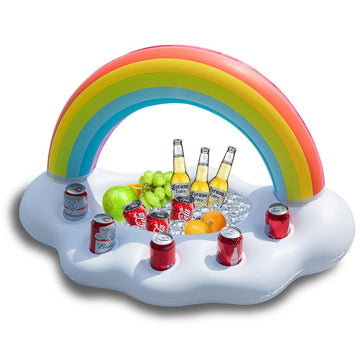Cleaning and Refreshing Your Pool Toys
Pool toys can really liven up your water fun and add to the summer experience, but just like your pool needs regular inspection, so do your toys. The last thing you want is for your family to play with damaged or dirty pool toys. But with a little planning—and scrubbing—it’s easy to keep your toys fresh all season long.
Start with a clean slate
It’s a good idea to inspect your pool toys before every use to ensure they’re sturdy and safe. Before using inflatable toys, check that all plugs are secure and that there are no holes that could cause air leaks. If there are wear and tear or weakening of the material, you could patch it, but we recommend just replacing the toy.
Keeping toys clean
If you’re using your pool toys regularly, the chlorine in your pool should do a good job of keeping them clean. But they still might start to feel grimy with mildew or mold from time to time due to the wet pool environment. Sometimes, pool toys will get a slimy, slippery feel to them. That stuff is usually algae or a form of mold.
When your family comes into contact with dirty toys consistently, the bacteria can cause a cold or an earache.
The best way to clean your toys is with a solution of bleach and water. Before you get started, make sure you’re wearing rubber gloves and protective eyewear, such as splash goggles. Also, take steps to avoid splashing the solution because it could damage your clothes. In a pail, carefully add 16 ounces of household bleach to a gallon of water. Then dip a scrub brush into the mixture and lightly wash the affected area.
Be sure to do this on a concrete surface or gravel area because the solution of bleach water will damage a lawn. Once you’re finished, use a garden hose to rinse the toy and work area thoroughly of any leftover solution.
Remember to be extra careful with foam toys. Because the material is porous, any bacteria or mold will grow quickly and be harder to see. We recommend cleaning foam toys three to four times a year. But if you see signs of mold or the foam starts to break off, it’s time to replace the toys. You can treat plastic toys on an as-needed basis because any bacteria will be easy to see.
Storing them away
If it’s the end of the pool season or if you won’t be using your pool toys for a significant amount of time, it’s important to dry them completely so leftover moisture does not cause bacteria to grow—which will happen in warmer weather. We recommend wiping toys down again with a bleach-water solution before putting them into storage and be sure to rinse and dry them thoroughly. Then deflate the inflatable toys, and store everything in an enclosed, dry space so it’s ready for your next round of pool fun.
Start with a clean slate
It’s a good idea to inspect your pool toys before every use to ensure they’re sturdy and safe. Before using inflatable toys, check that all plugs are secure and that there are no holes that could cause air leaks. If there are wear and tear or weakening of the material, you could patch it, but we recommend just replacing the toy.
Keeping toys clean
If you’re using your pool toys regularly, the chlorine in your pool should do a good job of keeping them clean. But they still might start to feel grimy with mildew or mold from time to time due to the wet pool environment. Sometimes, pool toys will get a slimy, slippery feel to them. That stuff is usually algae or a form of mold.
When your family comes into contact with dirty toys consistently, the bacteria can cause a cold or an earache.
The best way to clean your toys is with a solution of bleach and water. Before you get started, make sure you’re wearing rubber gloves and protective eyewear, such as splash goggles. Also, take steps to avoid splashing the solution because it could damage your clothes. In a pail, carefully add 16 ounces of household bleach to a gallon of water. Then dip a scrub brush into the mixture and lightly wash the affected area.
Be sure to do this on a concrete surface or gravel area because the solution of bleach water will damage a lawn. Once you’re finished, use a garden hose to rinse the toy and work area thoroughly of any leftover solution.
Remember to be extra careful with foam toys. Because the material is porous, any bacteria or mold will grow quickly and be harder to see. We recommend cleaning foam toys three to four times a year. But if you see signs of mold or the foam starts to break off, it’s time to replace the toys. You can treat plastic toys on an as-needed basis because any bacteria will be easy to see.
Storing them away
If it’s the end of the pool season or if you won’t be using your pool toys for a significant amount of time, it’s important to dry them completely so leftover moisture does not cause bacteria to grow—which will happen in warmer weather. We recommend wiping toys down again with a bleach-water solution before putting them into storage and be sure to rinse and dry them thoroughly. Then deflate the inflatable toys, and store everything in an enclosed, dry space so it’s ready for your next round of pool fun.







